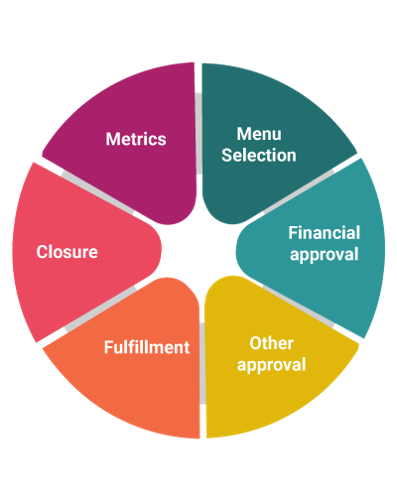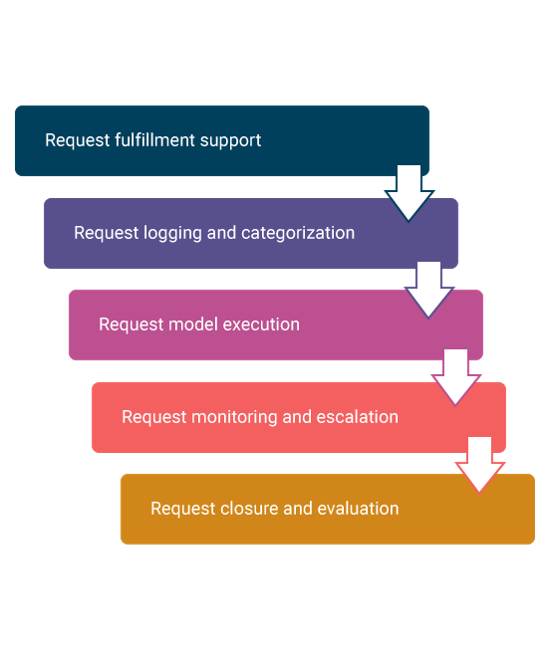
A formal request by a user for any service they require such as the installation of new software, change of hardware, or replacement of a component is called a service request. The official definition of service request given by ITIL is “a request from a user for information, advice, a standard change, or access to a service.” In this article, we will learn about the various aspects of ITIL service request fulfillment such as objectives, scope, processes, sub-processes, etc.
ITIL Service Request Fulfillment
The ITIL service requests fulfillment is usually for small changes or additions which have low risk, and low-cost, and occur quite frequently. Because of this, it would not be wise to club these requests along with high-risk ones, which is why it has been made into a separate process being handled by a dedicated team. The process of fulfilling the requests made is called request fulfillment.
Objectives of ITIL Service Request Fulfillment
The objectives of ITIL service request fulfillment are as follows:
-
Make the users aware of the availability of existing services and the procedure to request them
-
To create a separate channel through which users can request and receive the required service that has been granted prior approval
-
Obtain and deliver the requested standard services on time
-
To provide assistance with general information requests and complaints.
Scope of ITIL Service Request Fulfillment
A company will have several hundred service requests per day. It becomes tough to manage all of them unless there is a standardized model to outline and classify the request. The service request model should be built in such a way so as to consider the parameters mentioned below.
-
The person or team who will be in charge of handling the request needs to be appointed
-
The process used to deliver the service should be determined.
-
The service request should be fulfilled quickly and on time according to the predetermined time window or a service level agreement
-
If the response team is unable to fulfill the service request, an alternate path to escalate the request further should be taken
Activities of ITIL Service Request Fulfillment
-
Menu Selection
Usually, in an organization, service desks are used to raise requests. But present technology allows users to raise the requests themselves using self-help tools that are linked to the service management. A menu-like interface can be offered to users to select the details of the service request from a previously defined list.
-
Financial Approval
Certain service requests need another step after raising the requests to get the required financial approval. The user will have to get the necessary approval from the concerned superiors in charge of the financial activities of the company.
-
Other Approval
Sometimes the user may need to seek further approvals from a specific department to ensure that the request is in accordance with certain laid down standards or parameters. There should be an option in request fulfillment to define and check the necessity of such approvals.
-
Fulfillment
The fulfillment of the service request is dependent on the type of request that is raised. Certain requests can be fulfilled by the service desks themselves whereas some requests may need to be forwarded to specific departments.
-
Closure
After the service has been fulfilled, it needs to be referred back to the service desk so that the request can be closed and the request can be marked as solved. The service desk needs to ensure that the user is satisfied with the way the request has been solved before it can be marked as closed.
-
Metrics
In order to judge the efficiency and effectiveness of request fulfillment by the concerned departments, we need to analyze the following metrics to get an accurate picture of the whole process.
-
Total service requests
-
Breakdown of service requests at every stage
-
Present backlog of outstanding service requests
-
Mean time for handling each type of request
-
Percentage and exact number of requests completed within the agreed time frame
-
The average cost of each service request
-
Level of customer satisfaction with the handling of their requests
-
Sub-Process of ITIL Service Request Fulfillment
-
Request Fulfillment Support
Its objective is to provide the required tools, skills, and processes. And, maintain them for the effective and efficient handling of service requests.
-
Request Logging and Categorization
Its objective is to maintain a log and categorize the different types of service requests meticulously. It is done for faster and efficient processing. It also has to verify the authorization of the user to submit the request.
-
Request Model Execution
Its objective is to process the request within a previously agreed-to time frame.
-
Request Monitoring and Escalation
Its objective is to continuously monitor the service request’s processing status. So that changes can be made quickly if any problems such as service level breaches arise.
-
Request Closure and Evaluation
Its objective is to submit the final records of the request to a quality control department for final inspection before the request is closed. They aim to make sure that the service is processed properly and all the necessary information is present in sufficient detail.
Conclusion
ITIL Service Request fulfillment thus makes the users aware of the availability of existing services. The procedure to request them and creates a separate channel through which users can request and receive the required service that has been granted prior approval. Obtaining and delivering the requested standard services on time provides assistance with general information requests and complaints. Learn more about the ITIL 4 skills and best practices with ITIL 4 Foundation certification, and give yourself a chance to excel in the IT Service Management industry.
Know more about Service Management best practices through Invensis Learning’s IT Service Management certification training on ITIL 4 Training and Certification, SIAM Foundation, SIAM professional, VeriSM, etc.
















